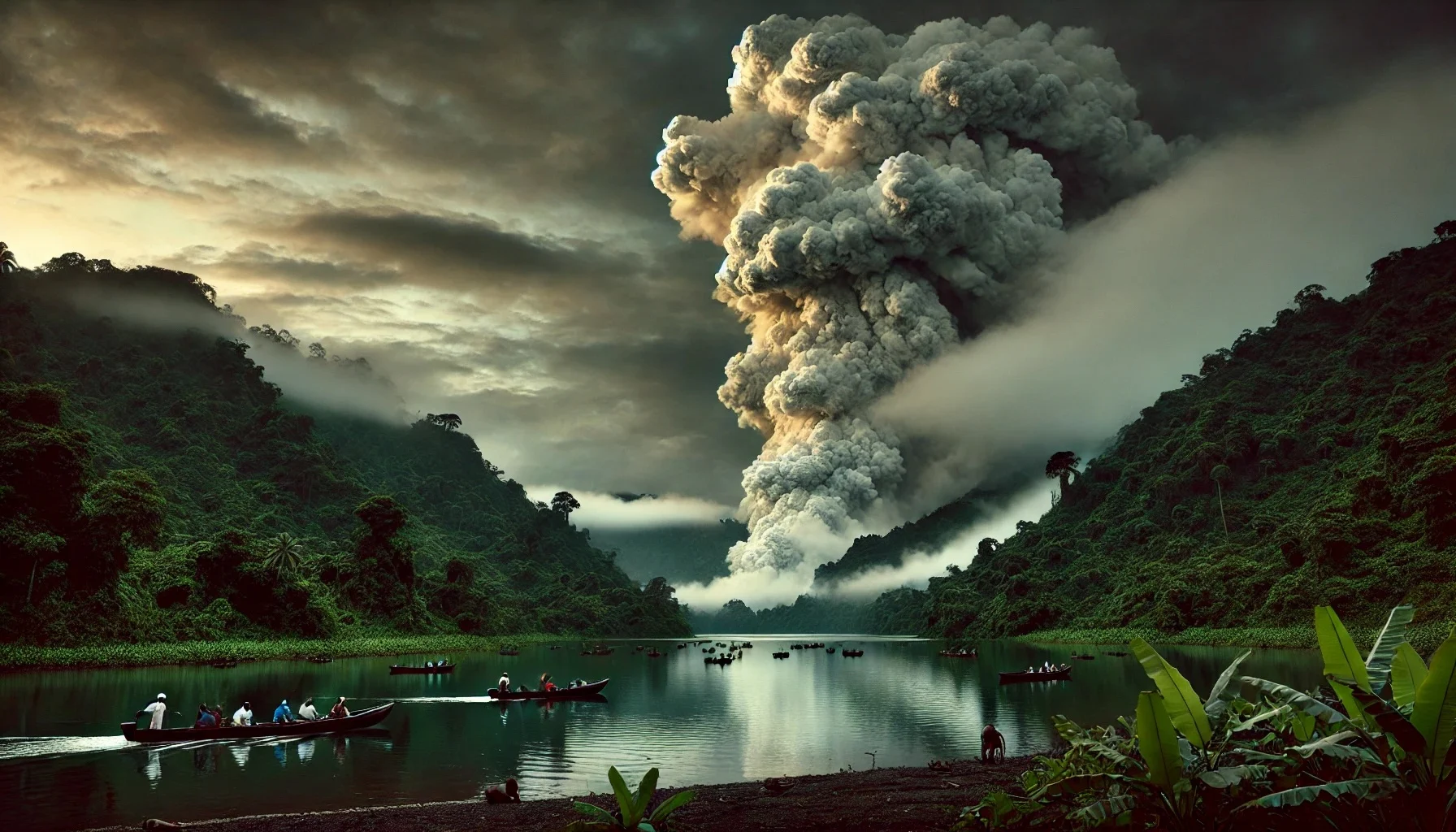
The Lake Nyos Disaster
by: The Calamity Calendar Team
August 21, 1986
The Calm Before the Storm
Lake Nyos, nestled in the verdant hills of Cameroon’s Northwest Region, is a place of breathtaking beauty. The deep blue waters of this crater lake are surrounded by lush green mountains, creating a postcard-perfect landscape. The lake’s peaceful surface belies the violent geological forces that shaped it, and for the villagers living nearby, it was simply a part of their everyday life—a source of water, fish, and sustenance.
But Lake Nyos was hiding a dark secret. Deep beneath its placid waters, volcanic gases were slowly accumulating, creating a ticking time bomb. These gases seeped from the Earth's mantle into the bottom of the lake, where the weight of the water kept them trapped under immense pressure. Over time, the concentration of carbon dioxide (CO2) at the lake’s depths reached dangerously high levels. Yet, life around the lake continued uninterrupted, as the people of Nyos and surrounding villages went about their daily routines, unaware of the peril lurking below.
A Sudden and Silent Death
On the evening of August 21, 1986, the calm was shattered in a way that no one could have anticipated. As night fell, something—perhaps a landslide or a minor earthquake—disturbed the delicate balance within the lake. The disturbance triggered a limnic eruption, a rare and deadly natural event where the CO2 trapped at the bottom of the lake suddenly surged to the surface.
In an instant, over 1.6 million tons of CO2 erupted from the lake in a massive cloud. The gas, being heavier than air, hugged the ground and flowed silently down the valleys surrounding the lake. It moved like a creeping fog, invisible and odorless, but lethally potent. As the CO2 cloud spread, it displaced the oxygen in the air, suffocating everything in its path.
Villages like Nyos, Subum, and Cha, lying within the 25-kilometer radius of the lake, were hit hardest. People and animals alike were caught completely off-guard. In the dark of night, as the deadly gas enveloped their homes, they simply collapsed where they stood or lay, never waking up again. Some survivors later recalled the eerie silence of the disaster—no warning, no sound, just a sudden loss of consciousness as death swept through the area.
By morning, the scale of the tragedy became horrifyingly clear. Nearly 1,746 people were dead, along with 3,500 livestock. Entire families were wiped out, and the once-thriving villages were left ghostly and silent, with bodies strewn across the landscape.
Thanks for subscribing!
The Aftermath and the Search for Answers
The world was shocked by the news of the Lake Nyos disaster. The Cameroonian government, along with international aid organizations, rushed to the scene, but there was little they could do for the dead. The priority shifted to helping the survivors—those few who had somehow escaped the lethal gas cloud.
Emergency response efforts were challenging. The remote location of the disaster zone made it difficult to get supplies and medical help to those in need. Survivors were evacuated and resettled, but the psychological toll of the disaster lingered. The people of Lake Nyos had lost not only their loved ones but also their homes, livestock, and way of life.
As the dust settled, scientists began to investigate what had happened. The concept of a limnic eruption was little known at the time, but the Lake Nyos disaster forced the world to pay attention. It became clear that the buildup of CO2 at the bottom of the lake had created a deadly situation, one that could happen again if steps weren’t taken to prevent it.
Preventing the Next Disaster
In the years following the Lake Nyos disaster, scientists devised a plan to prevent another tragedy. French experts led the effort to install a degassing system in the lake. This system, composed of a series of pipes, was designed to gradually release the CO2 from the depths of the lake, reducing the risk of a sudden, catastrophic eruption.
By 1995, the degassing efforts were in full swing, and the CO2 levels in Lake Nyos began to drop. The danger was not entirely eliminated, but it was significantly reduced. Similar efforts were made at Lake Monoun, another Cameroonian crater lake that had experienced a smaller, but still deadly, limnic eruption two years earlier.
Lessons Learned and Ongoing Vigilance
The Lake Nyos disaster changed the way scientists approach volcanic lakes. It highlighted the need for constant monitoring and early warning systems in areas where similar disasters could occur. Today, Lake Nyos is still monitored closely, with scientists keeping a watchful eye on CO2 levels to ensure that history does not repeat itself.
The story of Lake Nyos is a tragic reminder of nature’s power and unpredictability. What seemed like a serene, harmless lake turned out to be a silent killer, claiming nearly 2,000 lives in a matter of hours. But it’s also a story of resilience and the determination to prevent such a catastrophe from happening again. Through science and vigilance, the memory of those lost at Lake Nyos continues to drive efforts to protect others from the same fate.
Stay in the Loop!
Become a Calamity Insider and get exclusive Calamity Calendar updates delivered straight to your inbox.
Thanks! You're now subscribed.